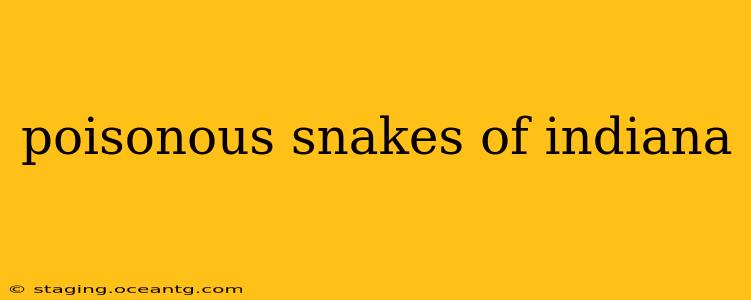Indiana, with its diverse landscapes ranging from forests and prairies to wetlands, is home to a variety of snake species. While many are harmless, a few venomous snakes call the Hoosier State home. Understanding these snakes is crucial for safety and appreciating Indiana's natural biodiversity. This guide provides comprehensive information on the poisonous snakes found in Indiana, addressing common questions and misconceptions.
What are the venomous snakes in Indiana?
Indiana has only two venomous snake species: the timber rattlesnake (Crotalus horridus) and the copperhead (Agkistrodon contortrix). It's crucial to remember that "poisonous" refers to animals that inflict harm through ingestion (like a poison dart frog), while "venomous" refers to animals that inject venom through a bite (like snakes). Therefore, the correct term for Indiana's dangerous snakes is venomous.
How can I identify a venomous snake in Indiana?
Identifying venomous snakes accurately requires careful observation and attention to detail. Both timber rattlesnakes and copperheads possess key characteristics, but relying solely on images can be misleading. It is always best to err on the side of caution and treat any snake you're uncertain about as potentially venomous.
Timber Rattlesnake: This large snake boasts a thick body, keeled scales (scales with a raised ridge down the center), and a distinctive rattle at the end of its tail. Their coloration varies but often features a brownish-gray or tan base with darker crossbands.
Copperhead: This smaller snake has a distinctive copper-colored head (hence the name), a slender body, and hourglass-shaped, dark brown or reddish-brown crossbands on a light brown or tan background.
What should I do if I encounter a venomous snake?
Safety First: Your priority is to avoid contact with the snake. Do not attempt to handle it or try to kill it. Maintain a safe distance, and carefully back away without making sudden movements.
Seek Medical Attention: If bitten, immediately seek medical attention. Call 911 or get to the nearest hospital. If possible, note the snake's characteristics (color, pattern, size) to help medical professionals administer the correct treatment. Do not try to capture the snake for identification purposes; your safety is paramount.
Are all snakes in Indiana venomous?
No, the vast majority of snakes in Indiana are non-venomous. Many people mistakenly identify harmless snakes as venomous due to their appearance. It's essential to learn about the common non-venomous species in your area to distinguish them from the venomous ones. Resources like field guides and online databases can aid in identification.
How common are venomous snake bites in Indiana?
While venomous snakes exist in Indiana, bites are relatively uncommon. Most bites occur when people inadvertently step on or otherwise handle a snake. Practicing caution and avoiding areas where snakes might reside significantly reduces the risk of a bite.
Where in Indiana are venomous snakes most commonly found?
Timber rattlesnakes and copperheads prefer habitats with rocky areas, wooded regions, and areas near water sources. They are more commonly found in southern Indiana, but their range can extend to other parts of the state, especially in suitable environments.
What is the best way to prevent snake bites?
The best prevention strategy is awareness and caution. When hiking or spending time outdoors in areas where venomous snakes might be present:
- Wear appropriate footwear, such as sturdy boots.
- Stick to well-maintained trails.
- Avoid reaching into crevices or under rocks.
- Be cautious when handling brush or debris.
- Keep pets leashed, as they are more prone to snake encounters.
What first aid should I administer if bitten by a venomous snake?
The best first aid for a venomous snake bite is immediate professional medical attention. Do not attempt home remedies or folk treatments. Keep the bitten area still and immobilized, call 911, and get to the nearest hospital.
This information is for educational purposes only and should not be considered a substitute for professional medical advice. Always seek professional medical attention if bitten by a snake. Remember, responsible interaction with wildlife involves observation from a safe distance and respecting their habitat.
